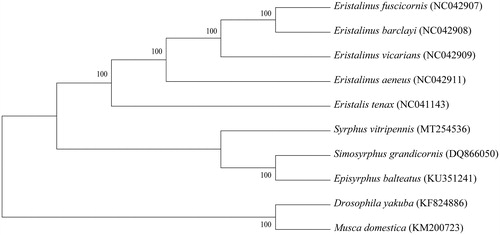Abstract
The complete mitochondrial genome of Syrphus vitripennis was sequenced and reported here. The circle genome of S. vitripennis is 16,185 bp in length. There are 38 sequence elements including 13 protein coding genes, 22 tRNA genes, 2 rRNA genes, and a control region. The order of all elements was the same with that of Eristalia cerealis. With two species from Muscidae and Drosophilidae as outgroups, phylogenetic relationships of eight Syrphidae species based on mitogenomes were in complete agreement with their taxonomic relationships based on morphological characteristics. Our result will provide more fundamental data to the development of the molecular systematics of Syrphidae.
Keywords:
Syrphus vitripennis, belongs to the Eristalini tribe in family Syrphidae, one of the most diverse families in Diptera, including about 6000 described species worldwide (Mengual et al. Citation2008). Due to Syrphidae insects’ peculiar behavior of hovering in sun over the flowers to feed on pollen and nectar, they are commonly known as flower flies and hoverflies or sunflies (Khan Citation2017). Here, we sequenced the complete mitogenome of S. vitripennis, to provide more fundamental data to the development of the DNA barcoding system.
In this study, S. vitripennis adults were collected from Xining Botanical Garden, Qinghai, China (36°37′36″ N, 101°44′58″ E) in September 2019 and kept in the Insect Collection of the Entomology Lab, College of Agriculture and Animal Husbandry, Qinghai University, Xining, China (accession number: YJY-2019-SYY004). After genomic DNA extraction, genomic sequencing was performed on the Illumina HiSeq Platform (Illumina, San Diego, CA) with a read length of 150 bp. The software SPAdes v.3.14.0 (Bankevich et al. Citation2012) was employed to assemble the mitogenome. The assembled sequence was then annotated using the web server MITOS (Bernt et al. Citation2013).
A circularized DNA assembly 16,185 bp in length was harvested and deposited in the GenBank with accession number of MT254536. Like reported Syrphidae mitogenomes, 37 genes are recognized in this mitogenome: 13 protein-coding genes (PCGs), 22 transfer RNA (tRNA) genes, and two ribosomal RNA (rRNA) genes, as well as a control region (D-loop). Of all 38 sequence elements, four PCGs, eight tRNA genes, and two rRNA genes are located on the light strand, while others are on the heavy strand. The order of all elements distributed on the sequence is consistent with that of Eristalia cerealis (Yan et al. Citation2020).
Based on mitogenomes assembled here or downloaded from GenBank, phylogenetic relationships of eight Syrphidae species with two species from Muscidae and Drosophilidae as outgroups were resolved by means of neighbor-joining (). After aligned using MAFFT (Katoh and Standley Citation2013), the neighbor-joining tree was built using MEGA7 (Kumar et al. Citation2016) with bootstrap set to 1000. Phylogenetic relationships indicated by the phylogenetic tree were in complete agreement with their taxonomic relationships based on morphological characteristics.
Disclosure statement
No potential conflict of interest was reported by the author(s).
Data availability
The dataset was deposited on the National Center for Biotechnology Information (NCBI, accession number MT254536).
Additional information
Funding
References
- Bankevich A, Nurk S, Antipov D, Gurevich AA, Dvorkin M, Kulikov AS, Lesin VM, Nikolenko SI, Pham S, Prjibelski AD, et al. 2012. SPAdes: a new genome assembly algorithm and its applications to single-cell sequencing. J Comput Biol. 19(5):455–477.
- Bernt M, Donath A, Jühling F, Externbrink F, Florentz C, Fritzsch G, Pütz J, Middendorf M, Stadler PF. 2013. MITOS: improved de novo metazoan mitochondrial genome annotation. Mol Phylogenet Evol. 69(2):313–319.
- Katoh K, Standley DM. 2013. MAFFT multiple sequence alignment software version 7: improvements in performance and usability. Mol Biol Evol. 30(4):772–780.
- Khan AA. 2017. Effect of insecticides on biodiversity of aphidophagous syrphid flies in fruit ecosystem of Kashmir. J Entomol Zool Stud. 5(4):117–125.
- Kumar S, Stecher G, Tamura K. 2016. MEGA7: molecular evolutionary genetics analysis version 7.0 for bigger datasets. Mol Biol Evol. 33(7):1870–1874.
- Mengual X, Ståhls G, Rojo S. 2008. Molecular phylogeny of Allograpta (Diptera, Syrphidae) reveals diversity of lineages and non-monophyly of phytophagous taxa. Mol Phylogenet Evol. 49(3):715–727.
- Yan J, Feng S, Song P, Li Y, Li W, Liu D, Ju X. 2020. Characterization and phylogenetic analysis of the complete mitochondrial genome of Eristalia cerealis (Diptera: Syrphidae). Mitochondr DNA B. 5(1):1005–1006.

